maintenance OLDSMOBILE SILHOUETTE 1997 User Guide
[x] Cancel search | Manufacturer: OLDSMOBILE, Model Year: 1997, Model line: SILHOUETTE, Model: OLDSMOBILE SILHOUETTE 1997Pages: 436, PDF Size: 21.87 MB
Page 323 of 436
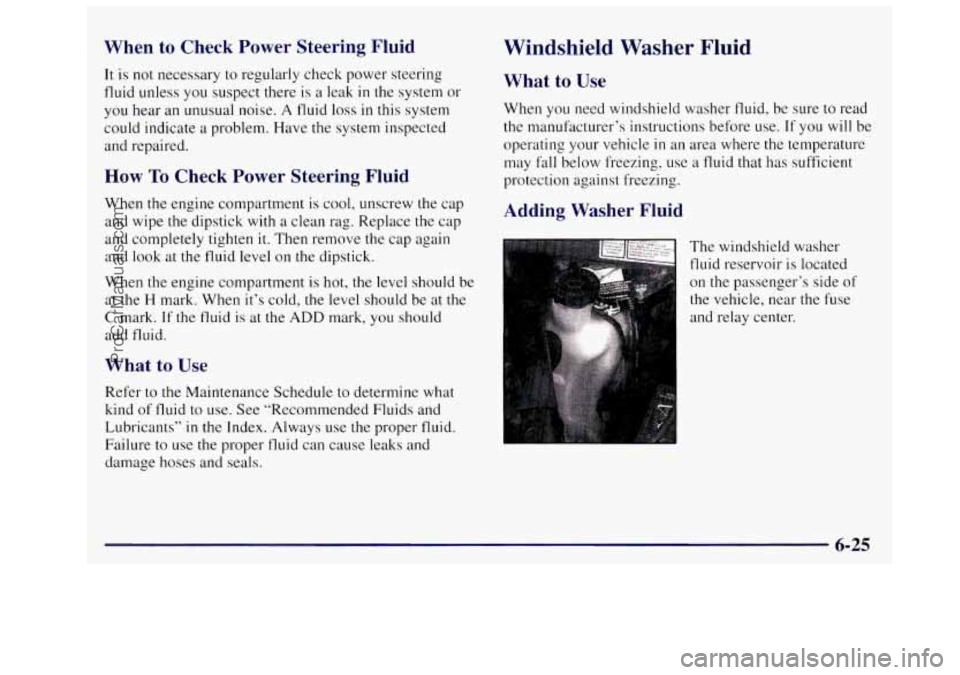
When to Check Power Steering Fluid
It is not necessary to regularly check power steering
fluid unless you suspect there
is a leak in the system or
you hear an unusual noise. A fluid loss in this system
could indicate
a problem. Have the system inspected
and repaired.
How To Check Power Steering Fluid
When the engine compartment is cool, unscrew the cap
and wipe the dipstick with
a clean rag. Replace the cap
and completely tighten
it. Then remove the cap again
and look at the fluid level on the dipstick.
When the engine compartment is hot,
the level should be
at the
H mark. When it’s cold, the level should be at the
C mark. If the fluid is at the ADD mark, you should
add fluid.
What to Use
Refer to the Maintenance Schedule to determine what
kind of fluid to use. See “Recommended Fluids and
Lubricants”
in the Index. Always use the proper fluid.
Failure to use the proper fluid can cause leaks and
damage hoses and seals.
Windshield Washer Fluid
What to Use
When you need windshield washer fluid, be sure to read
the manufacturer’s instructions before use.
If you will be
operating your vehicle
in an area where the temperature
may Pall below freezing, use
a fluid that has sufficient
protection against freezing.
Adding Washer Fluid
The windshield washer
fluid reservoir is located
on the passenger’s side of
the vehicle, near the fuse
6-25
ProCarManuals.com
Page 339 of 436
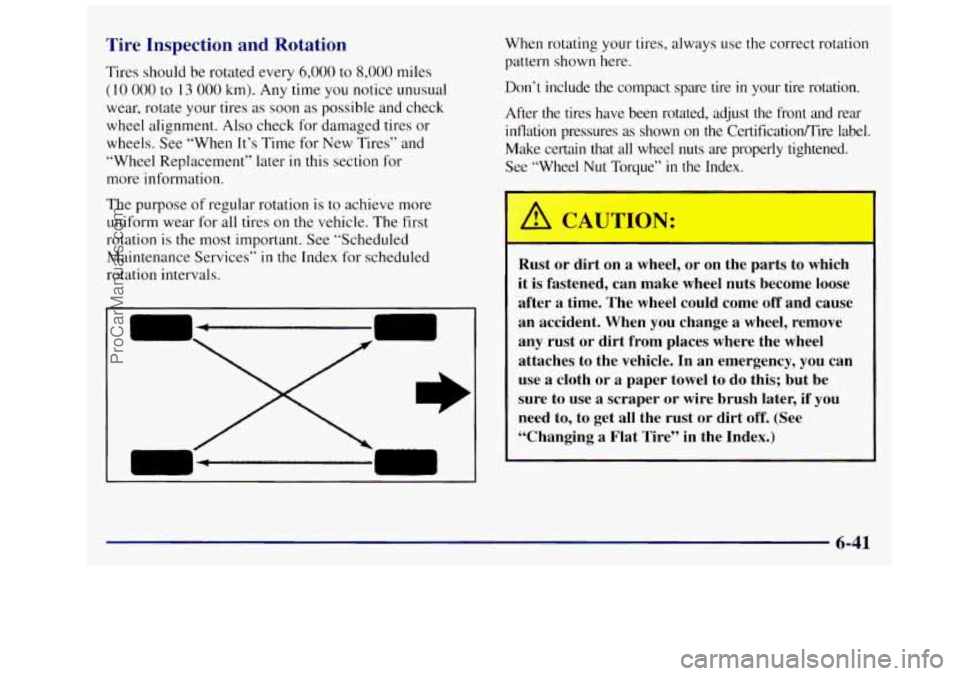
Tire Inspection and Rotation
Tires should be rotated every 6,000 to 8,000 miles
(10 000 to 13 000 km). Any time you notice unusual
wear, rotate your tires
as soon as possible and check
wheel alignment. Also check for damaged tires or
wheels. See “When It’s Time for New Tires” and
“Wheel Replacement” later
in this section for
more information.
The purpose of regular rotation is
to achieve more
uniform wear for all tires on the vehicle. The first
rotation is the most important. See “Scheduled
Maintenance Services”
in the Index for scheduled
rotation intervals. When
rotating
your tires, always use the correct rotation
pattern shown here.
Don’t include the compact spare tire
in your tire rotation.
After the tires have been rotated, adjust the front and rear
inflation pressures
as shown on the Certificatioflire label.
Make certain that all wheel
nuts are properly tightened.
See “Wheel Nut Torque”
in the Index.
Rust or dirt on
a wheel, or on the parts to which
it is fastened, can make wheel nuts become loose
after
a time. The wheel could come off and cause
an accident. When you change a wheel, remove
any rust or dirt from places where the wheel
attaches to the vehicle. In an emergency, you can
use
a cloth or a paper towel to do this; but be
sure to use
a scraper or wire brush later, if you
need to, to get
all the rust or dirt off. (See
“Changing a Flat Tire” in the Index.)
6-41
ProCarManuals.com
Page 351 of 436
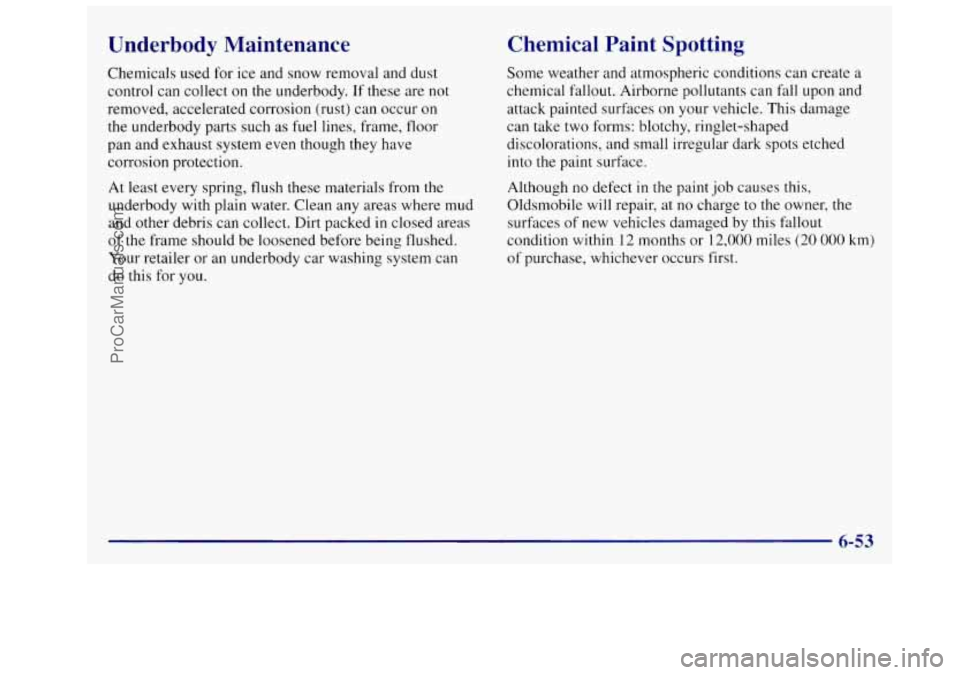
Underbody Maintenance
Chemicals used for ice and snow removal and dust
control can collect on the underbody.
If these are not
removed, accelerated corrosion (rust) can occur on
the underbody parts such
as fuel lines, frame, floor
pan and exhaust system even though they have
corrosion protection.
At least every spring, flush these materials from
the
underbody with plain water. Clean any areas where mud
and other debris can collect. Dirt packed
in closed areas
of
the frame should be loosened before being flushed.
Your retailer or an underbody car washing system can
do this for you.
Chemical Paint Spotting
Some weather and atmospheric conditions can create a
chemical fallout. Airborne pollutants can fall upon and
attack painted surfaces on your vehicle. This damage
can take two forms: blotchy, ringlet-shaped
discolorations, and small irregular dark spots etched
into the paint surface.
Although no defect
in the paint job causes this,
Oldsmobile
will repair, at no charge to the owner, the
surfaces of new vehicles damaged by this fallout
condition within 12 months or 12,000 miles (20 000
km)
of purchase, whichever occurs first.
6-53
ProCarManuals.com
Page 361 of 436

Engine Specifications
Engine VTN Code ........................... E
EngineType .............................. V6
Firing Order
...................... 1-2-3-4-5-6
Horsepower
............................. I85
Thermostat Temperature
Specification
................... 195°F (91 “C)
Vehicle Dimensions - Long Wheel Base
Length ...................... 201.3” (51 1.5 cm)
Width
........................ 72.0” (1 83.0 cm)
Height
........................ 68.1’’ (1 73.1 cm)
Wheelbase
.................... 120” (304.7 cm)
Front Tread Width
............. 6 1.5” ( 1 56.2 cm)
Rear Tread Width
............. 63.3” ( 160.8 cm)
Vehicle Dimensions - Short Wheel Base
Length ...................... 187.4” (475.9 cm)
Width
........................ 72.0” (1 83.0 cm)
Height
........................ 67.4” (171.2 cm)
Wheelbase
.................... 1 12” (284.5 cm)
Front Tread Width
............. 6 1 Sf‘ ( 156.2 cm)
Rear Tread Width ............. 63.3” ( 160.8 cm)
Normal Maintenance Replacement Parts
Air Cleaner Filter .............. AC Type A-974C
Pollen Filter
(2) ..................... 52470574
Engine
Oil Filter ........................ PF47
Spark Plugs
................... AC Type 41-940
Gap: 0.060 ” (1.52 mm)
Windshield Wiper Blades Length
........................ 24” (600 mm)
Type ......................... Shepard’s Hook
Length ........................ 16” (406 mm)
Type
......................... Shepard’s Hook
Backglass Wiper
Blade
6-63
ProCarManuals.com
Page 363 of 436
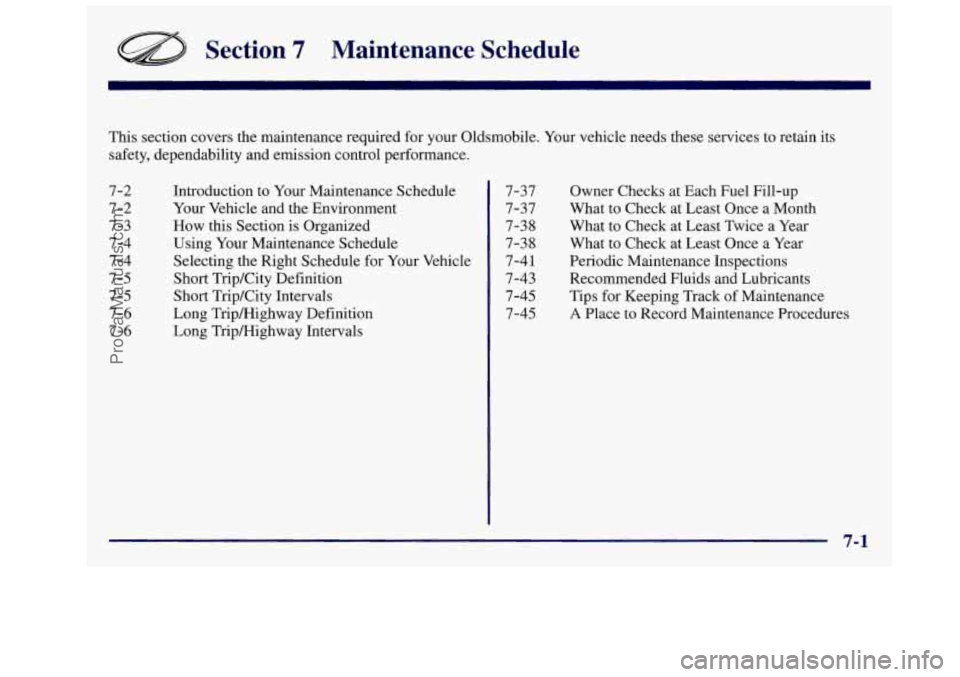
Section 7 Maintenance Schedule
Owner Checks at Each Fuel Fill-up
What to Check at Least Once a Month
What to Check at Least Twice a Year
What to Check at Least Once
a Year
Periodic Maintenance Inspections
Recommended Fluids and Lubricants
Tips for Keeping Track of Maintenance
A Place to Record Maintenance Procedures
This section covers the maintenance required for your Oldsmobile\
.
Your vehicle needs these services to retain its
safety, dependability and emission control performance.
7-2 Introduction to Your Maintenance Schedule
7-37
7-2
Your Vehicle and the Environment 7-37
7-3 How this Section is Organized
7-43
7-5 Short
TripKity Definition 7-41
7-4 Selecting
the Right Schedule for Your Vehicle 7-38
7-4 Using
Your Maintenance Schedule 7-38
7-45
7-5 Short
Trip/City Intervals
7-6 Long Tripmighway Definition
7-6 Long Tripmighway Intervals 7-45
ProCarManuals.com
Page 364 of 436
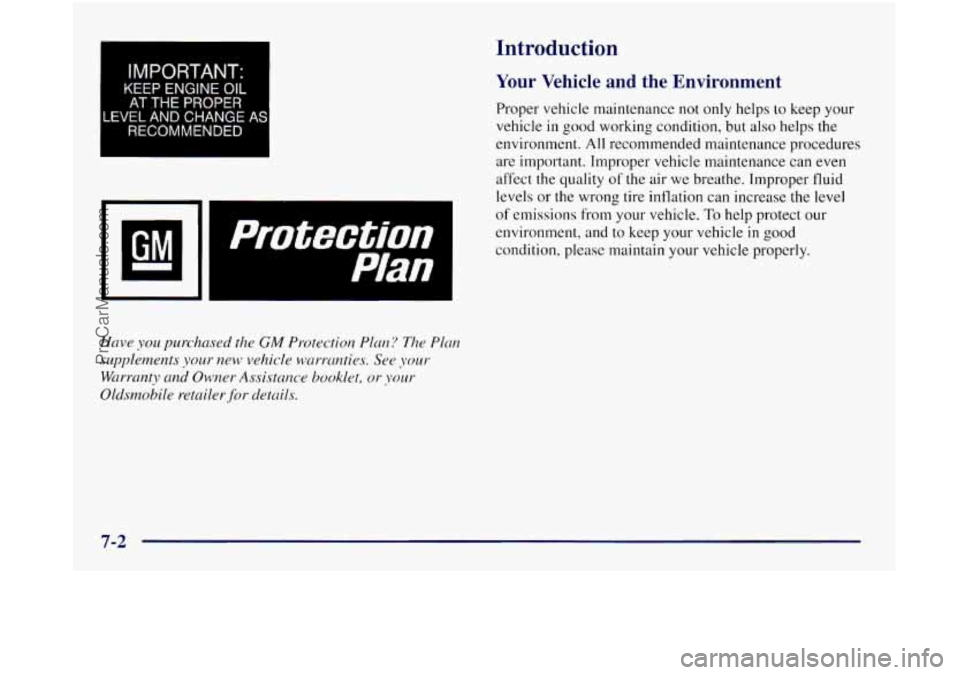
I IMPORTANT: I
KEEP ENGINE OIL
AT THE PROPER
LEVEL AND CHANGE AS
RECOMMENDED
protection Plan I
Have you purchased the GM Protection Plm? The Plan
supplements your new vehicle warrmties. See your
Warranty and Owner Assistance booklet, or your
Oldmobile retailer
for details.
Introduction
Your Vehicle and the Environment
Proper vehicle maintenance not only helps to keep your
vehicle
in good working condition, but also helps the
environment.
All recommended maintenance procedures
are important. Improper vehicle maintenance can
even
affect the quality of the air we breathe. Improper fluid
levels or the wrong tire inflation can increase the
level
of emissions from your vehicle. To help protect our
environment, and to keep your vehicle
in good
condition, please maintain your vehicle properly.
7-2
ProCarManuals.com
Page 365 of 436
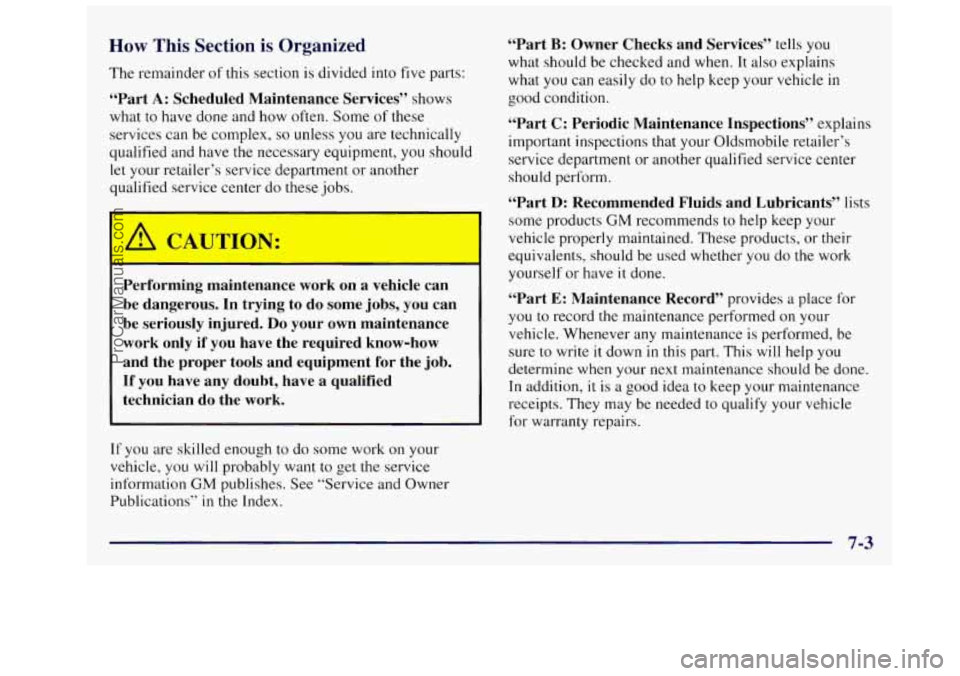
How This Section is Organized
The remainder of this section is divided into five parts:
“Part
A: Scheduled Maintenance Services” shows
what to have done and how often. Some of these
services can be complex,
so unless you are technically
qualified and have
the necessary equipment, you should
let your retailer’s service department or another
qualified service center do these jobs.
-
Performing maintenance work on a vehicle can
be dangerous. In trying to do some jobs, you can
be seriously injured.
Do your own maintenance
work only if you have the required know-how
and the proper tools and equipment for the job.
If you have any doubt, have
a qualified
technician do the work.
If you are skilled enough to do some work on your
vehicle, you will probably want to get
the service
information
GM publishes. See “Service and Owner
Publications”
in the Index. “Part
B: Owner Checks and Services”
tells you
what should be checked and when. It also explains
what you can easily do to help keep your vehicle
in
good condition.
“Part C: Periodic Maintenance Inspections” explains
important inspections that your Oldsmobile retailer’s
service department or another qualified service center
should perform.
“Part
D: Recommended Fluids and Lubricants” lists
some products
GM recommends to help keep your
vehicle properly maintained. These products, or their
equivalents, should be used whether you do the work
yourself or have
it done.
“Part E: Maintenance Record’’ provides a place for
you to record the maintenance performed on your
vehicle. Whenever any maintenance
is performed, be
sure to write
it down in this part. This will help you
determine when your
next maintenance should be done.
In addition,
it is a good idea to keep your maintenance
receipts. They may be needed to qualify your vehicle
for warranty repairs.
7-3
ProCarManuals.com
Page 366 of 436
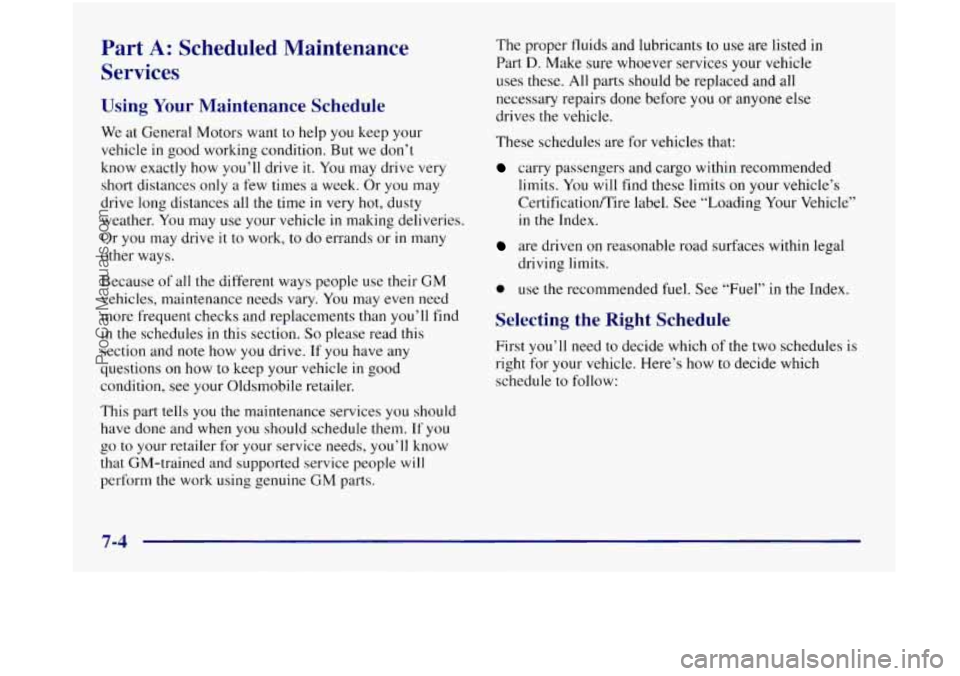
Part A: Scheduled Maintenance
Services
Using Your Maintenance Schedule
We at General Motors want to help you keep your
vehicle in good working condition. But we don’t
know exactly how you’ll drive it.
You may drive very
short distances only a few times a week. Or you may
drive long distances all the time
in very hot, dusty
weather.
You may use your vehicle in making deliveries.
Or you may drive
it to work, to do errands or in many
other ways.
Because of all the different ways people use their
GM
vehicles, maintenance needs vary. You may even need
more frequent checks and replacements than
you’ll find
in the schedules in this section. So please read this
section and note how
you drive. If you have any
questions on how to keep your vehicle
in good
condition, see your Oldsmobile retailer.
This part tells you the maintenance services you should
have done and when you should schedule them.
If you
go to your retailer for your service needs,
you’ll know
that GM-trained and supported service people will
perform the work using genuine GM parts. The
proper fluids and lubricants
to use are listed in
Part
D. Make sure whoever services your vehicle
uses these.
All parts should be replaced and all
necessary repairs done before
you or anyone else
drives the vehicle.
These schedules are for vehicles that:
carry passengers and cargo within recommended
limits.
You will find these limits on your vehicle’s
CertificatiodTire label. See “Loading Your Vehicle”
in the Index.
are driven on reasonable road surfaces within legal
driving limits.
0 use the recommended fuel. See “Fuel” in the Index.
Selecting the Right Schedule
First you’ll need to decide which of the two schedules is
right for your vehicle. Here’s how to decide which
schedule to follow:
7-4
ProCarManuals.com
Page 367 of 436

Maintenance Schedule
I Short Trip/City Definition I
Follow the Short Trip/City Maintenance Schedule if any
one of these conditions is true for your vehicle:
0
0
0
0
0
Most trips are less than 5 to 10 miles (8 to 16 km).
This is particularly important when outside
temperatures are below freezing.
Most trips include extensive idling (such as frequent
driving
in stop-and-go traffic).
Most trips are through dusty areas.
You frequently tow a trailer or use a carrier on top of
your vehicle.
If the vehicle is used for delivery service, police, taxi
or other commercial application.
One of the reasons you should follow this schedule
ifyo~1 operate your vehicle under any
sf these
conditions is that these conditions cause engine oil
to break down sooney:
Short Trip/City Intervals
Every 3,000 Miles (5 000 km): Engine Oil and Filter
Change (or
3 months, whichever occurs first).
Every 6,000 Miles (10 000 km): Tire Rotation.
Every 12,000 Miles (20 000 km): Passenger
Compartment Air Filter Replacement.
Every 15,000 Miles (25 000 km): Air Cleaner Filter
Inspection,
if driving in dusty conditions.
Every 30,000 Miles (50 000 km): Air Cleaner
Filter Replacement.
Every 50,000 Miles (83 000 km): Automatic Transaxle
Service (severe conditions only).
Every 60,000 Miles (100 000 km): Engine Accessory
Drive
Belt Inspection. Fuel Tmk, Cap and Lines
Inspection
(or every 60 months, whichever occurs first).
Every 100,000 Miles (166 000 km): Spark Plug Wire
Inspection. Spark Plug Replacement.
Every 150,000 Miles (240 000 km): Cooling System
Service (or every
60 months, whichever occurs first).
These intervals only sLlrnrnarize maintenance services.
Be sure to follow the complefe rnuintenance schedule on
the following pages.
ProCarManuals.com
Page 368 of 436
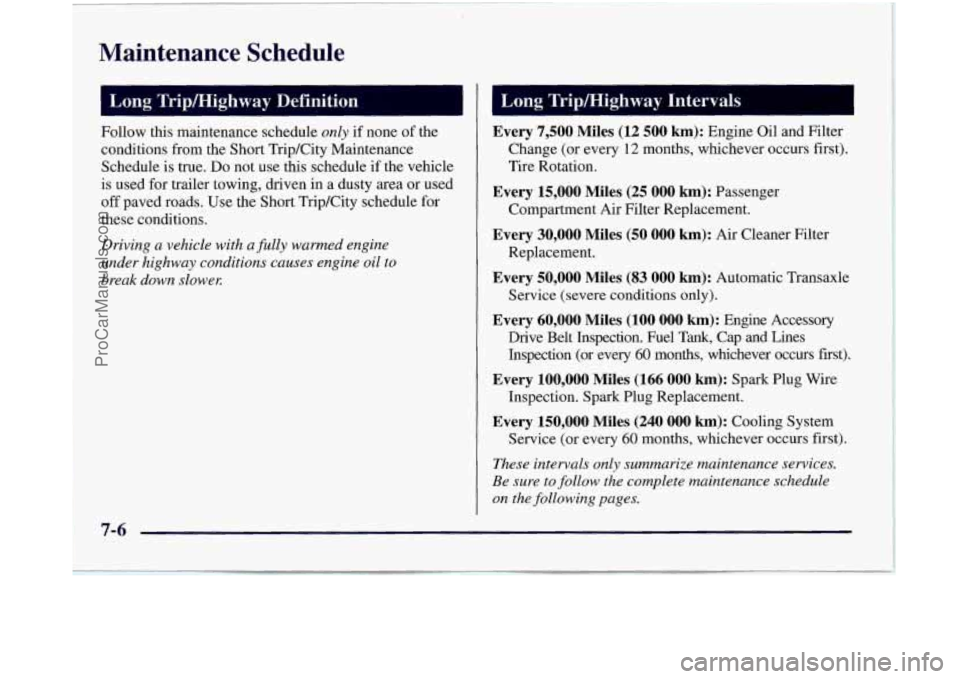
Maintenance Schedule
Long TridHiehwav Definition 1 m
Follow this maintenance schedule only if none of the Every 7,500 Miles (12 500 km): Engine Oil and Filter
conditions from the Short Trip/City Maintenance Change (or
every
12 months, whichever occurs first).
Schedule is true.
Do not use this schedule if the vehicle Tire Rotation.
is used for trailer towing, driven in a dusty area or used
off paved roads. Use the Short Trip/City schedule for
these conditions.
Driving a vehicle with a fully warmed engine
under highway conditions causes engine oil to
break down slowex
Every 15,000 Miles (25 000 km): Passenger
Every 30,000 Miles (50 000 km): Air Cleaner Filter
Every 50,000 Miles (83 000 km): Automatic Transaxle
Every 60,000 Miles (100 000 km): Engine Accessory
Compartment Air Filter Replacement.
Replacement. Service (severe conditions only).
Drive Belt Inspection. Fuel
Tank, Cap and Lines
Inspection (or every
60 months, whichever occurs first).
Inspection. Spark Plug Replacement.
Service (or every
60 months, whichever occurs first).
Every 100,000 Miles (166 000 km): Spark Plug Wire
Every 150,000 Miles (240 000 km): Cooling System
These intervals only summarize maintenance services.
Be sure to follow the complete maintenance schedule
on the following pages.
7-6
I Long Tripmighway Intervals 1
ProCarManuals.com